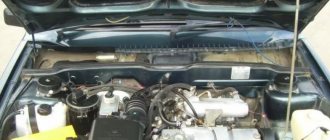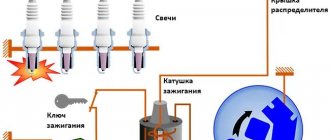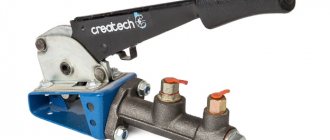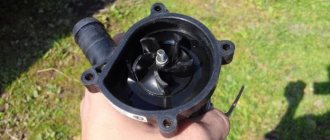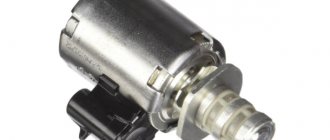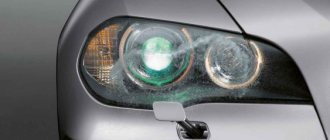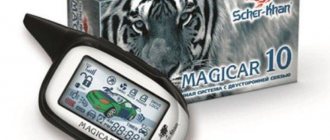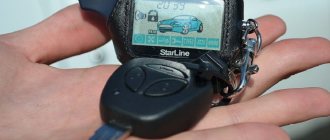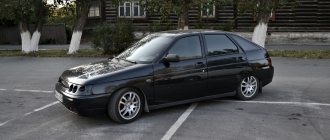Volzhsky Auto in 1982, and the last car left the assembly line 30 years later. The VAZ 2107 was originally planned as a luxury version of the previous fifth model. The car has a sedan-type body and rear-wheel drive, a comfortable interior and improved engine performance. The car turned out to be extremely successful and is still popular among Russians.
The car is easy to drive thanks to the hydraulic clutch, large steering wheel and optimal gear ratios. The VAZ 2107 model belongs to the so-called classic series, the prototype for which was the legendary “kopek” and the Italian Fiat 124. The manufacturer did not plan to install front-wheel drive; the “eight”, “nine” and “ninety-nine” were launched into the series. Such developments were carried out exclusively by enthusiasts, and perhaps some projects were implemented.
History of creation [edit | edit code]
The VAZ-2107 is a modified luxury version of the VAZ-2105, which, in turn, traces its origins to the Fiat 124, a subcompact family sedan from 1966 (winner of the 1967 European Car of the Year). The VAZ-2107 was exported under the names Lada Nova, Lada Riva, Lada Signet, Lada 1500
. [3]
From 2002 to 2012, the VAZ-21070 (modification of the VAZ-2107) was produced in Ukraine (LuAZ, ZAZ and KrASZ [4]). In May 2008, the assembly of LADA 2107 was launched at Argun in the Chechen Republic [5]. Since March 2011, the production of LADA 2107 has been mastered by the Izhevsk Automobile Plant.
Replacement of VAZ-2105 and VAZ-2106
By the mid-1970s, a crisis emerged at the Volzhsky enterprise. The fact is that all the models produced in Togliatti were in one way or another connected with the Italian “donor”. And not only the early “kopek” and “treshka”. Even the VAZ-2106 was unified with the Fiat 124 , although the model was positioned as its own development. Accordingly, the technical component and appearance of the Zhiguli were outdated. And something had to be done about this.
At that time, serious changes occurred in automobile fashion. Sharper shapes and right angles were now popular. Accordingly, the “six”, which appeared in 1976, initially looked outdated. And the management of the Volzhsky enterprise did not have to hope for the success of the model abroad.
It was then that a strategic decision was made - to cut ties with Fiat and do something of our own. The new model had to not only look modern, but also meet global requirements for exhaust gases, safety, and so on. In general, engineers and designers were required to take the product to a fundamentally different level.
In 1980, the VAZ-2105 . This car was very different from all other models of the Volga enterprise. It received a belt drive instead of a chain drive, a mounting block with relays and fuses appeared under the hood, single block headlights and massive tail lights appeared, and the seats were stuffed with polyurethane.
The model turned out to be successful and modern. But it lacked the polish to take a position in the “luxury” segment, where the “six” still ruled. And then the decision was made to create the “Seven” - an improved version of the “Five”.
Modifications [edit | edit code]
- LADA-2107 (engine 2103, 1.5 l, 8 cl., carburetor)
- LADA-21072 (engine 2105, 1.3 l, 8 cl., carburetor, timing belt drive)
- LADA-21073 (engine 1.7 l, 8 cells, mono injection - export version for the European market)
- LADA-21074 (engine 2106, 1.6 l, 8 cl., carburetor)
- LADA-2107-20 (engine 2104, 1.5 l, 8 cells, distributed injection, Euro-2[11])
- LADA-2107-71 (engine 1.4 l, 66 hp engine 21034 for A-76 gasoline, version for China)
- LADA-21074-20 (engine 21067-10, 1.6 l, 8 cells, distributed injection, Euro-2)
- LADA-21074-30 (engine 21067-20, 1.6 l, 8 cells, distributed injection, Euro-3)
- LADA-210740 (engine 21067, 1.6 l, 53 kW/72.7 hp 8 cells, injector, catalyst) (2007 onwards)
- LADA-21077 (engine 2105, 1.3 l, 8 cl., carburetor, timing belt drive - export version for the UK)
- LADA-21078 (engine 2106, 1.6 l, 8 cl., carburetor - export version for the UK)
- LADA-21079 (rotary piston engine 1.3 l, 140 hp, originally created for the needs of the Ministry of Internal Affairs and the KGB). Years of production: 1986—1991 [12]
- LADA-2107 ZNG (engine 21213, 1.7 l, 8 cells, central injection)
Unclaimed projects
The experimental design production of the car plant, in collaboration with developers, worked on promising concepts based on the existing platform. Various options were proposed, including front-wheel drive for the seven. The designers' achievements remained unclaimed; too much would have to be redone, including replacing the reliable hydraulic clutch drive with a cable one.
The latest developments on the VAZ 2107 model involved more external changes, what is commonly called restyling. A team of designers worked on the car; they did not touch upon technical issues; all components and systems, such as the clutch drive, distributed injection and electronic engine control unit, were preserved intact. The front and rear bumpers, hood and other elements have changed beyond recognition. However, the project remained unclaimed.
Source
Main differences from LADA 2105 [edit | edit code ]
- A more powerful engine with a volume of 1.5 liters and a power of 77 hp. With. (for carburetor versions);
- A modified, often chrome-plated radiator grille with a larger area (in the last years of production, the LADA-2104 was equipped with the same ones for unification purposes)
- The structure of the rear lights has been slightly changed (5-section instead of 6-section in 2105);
- More comfortable front seats with integrated headrests (in the last years of production, the LADA-2105, 2104 were equipped with the same ones for unification purposes);
- Some of the cars produced were equipped with a rigidly molded interior headliner and plastic ventilation linings for the rear pillars;
- Modernized front instrument panel (in particular, a tachometer and speedometer with digitization up to 180 km/h were added, as well as an oil pressure indicator (until 1988, after which it was replaced by an econometer;
- Added cold air deflectors (“torpedo”) located in the center. While a stream of hot air can be directed into the legs (through the interior heater), through these deflectors a stream of cold air can be directed into the face (only at speed, with the pressure of the oncoming air flow);
- Plastic bumpers with chrome plates instead of more massive aluminum ones (in the last years of production on LADA-2105, 2104, for the purpose of unification and reduction in cost, the same ones were installed);
- Changed shape of the hood (in the last years of production, the LADA-2104 was equipped with the same ones for unification purposes);
- Slightly changed shape of the trunk lid (without stampings), since 2008 they began to install a trunk lid with stampings, like the VAZ-2105, due to the unification of production;
- Some interior details have been changed: door upholstery, door lock buttons, radio panel (“beard”), gearshift knob, steering wheel shape (which later became uniform due to unification);
- The electrical system circuit differs (there are also differences between individual modifications depending on the type of engine).
VAZ-2107 in modern Russia
After the collapse of the Soviet Union, the VAZ-2107 continued to maintain its leading position in sales. The appearance of the new front-wheel drive Lada family did not particularly affect it. The only thing is that after the debut of the “ninety-nine”, it ceased to be considered the most luxurious car. Since the country was “out”, and the market economy dictated its harsh conditions, the “seven” lost its luster. In order to survive, the company seriously saved on everything. And, first of all, on the interior finishing materials.
The VAZ-2107 quickly became just a car without any “zest”. Then there was also the unification of the wheels of all cars of the Volga enterprise. In the new millennium, the process of cost reduction and unification continued. First, the “seven” lost its trunk lid, which was replaced with a spare part from the “five.” Then the thresholds “lost” the rubber moldings.
Since the VAZ-2107 was still a good car, repairable and inexpensive to maintain, it began to be assembled in Ukraine (in Lutsk, Zaporozhye and Kremenchug). In Russia, geography has also changed. Syzran, Chechnya, and Udmurtia appeared. But in 2012, production of the “seven” was officially discontinued. Moreover, both in Russia and in Ukraine. But the model, as they say, did not give up without a fight. She managed to hold out for another two years at the plant in Cairo, where Lada Egypt was engaged in its production.
Lada Egypt
In 2014, the “seven” finally retired. True, the model still has not sunk into oblivion. And more or less living specimens continue to be found to this day. The VAZ-2107 lasted on the assembly line for more than thirty years. And during this time, over 3.1 million copies were released.
Differences between cars of recent years [edit | edit code]
In cars of the last years of production (under the state car recycling program), in order to minimize the selling price, the maximum cost of elements was made relative to previously produced equipment. What we noticed: there are no ashtrays in the rear door trim; interior door handles are made of molded hard plastic (instead of rubberized material); There are no clothes hooks on the ceiling handrails; one weak and capricious sound signal “tablet” was used, instead of two “horns”. The 2010 car was not equipped with a pump. In addition, changes affected the appearance of the “seven”. Instead of a flat trunk lid, a lid with stamping from a VAZ-2105 appeared, and the plastic molding at the bottom of the body disappeared. They refused to paint the door pillars and frames black, and they abandoned the chrome-plated external door handles. Headlight washers and cleaners were no longer installed on cars of recent years of production.
Model description
The VAZ “Seven” was called “Soviet Mercedes” for its exterior; the car has a radiator grille of a very characteristic shape. On the technical side, the car was well equipped for its time:
- vacuum brake booster;
- hydraulic clutch;
- powerful engine;
- efficient optics.
The design of the car provides for drive to the rear axle; initially the gearbox was four-speed. The VAZ 2107 model is, in fact, the logical conclusion of the entire classic line, and further modernization would require a significant reworking of the entire structure. The development of cars with front-wheel drive or all-wheel drive was carried out within other lines.
Alternatives
VAZ 2107 is a rear-wheel drive domestic sedan belonging to the B-class. He has many competitors. Among them, particularly popular models produced simultaneously with the “seven” should be highlighted:
- Lada Priora. This domestic sedan actively competed with the VAZ 2107. It has a more attractive appearance, rich technical equipment and a comfortable interior. Priora was produced in three engine versions: sedan, hatchback and station wagon.
- Mitsubishi Galant. This Japanese beauty was produced simultaneously with the domestic Zhiguli. Buying a new Galant at that time was problematic - the pleasure was too expensive. However, now on the secondary market prices for both models have leveled off. By paying a penny, you can become the owner of a powerful, spacious sedan that can comfortably seat five people and take them to the ends of the world. However, it should be remembered that the old Galant requires large financial investments.
- Chevrolet Lacetti. Another foreign model that can lure potential buyers to its side. Nimble and roomy, it is perfect for daily use. It is noteworthy that the car is equipped with air conditioning, which is so necessary in the summer and which is so lacking in the “seven”. Spare parts for the Lacetti are inexpensive, but high quality. They can always be found in any auto store. The car, by the way, is capable of dynamic acceleration, so operating it in city conditions is a pleasure.
- Moskvich 2140. This is the cheapest competitor to the Seven. It was produced between 1976 and 1988. This Soviet car has rear-wheel drive, poor equipment and a 70 hp carburetor engine. At one time, Moskvich 2140 was in high demand not only on the Russian market, but also in Finland, Greece, and Scandinavia. The car was purchased both for personal use and for government needs. Despite the fact that the car left the production line more than 32 years ago, perfectly preserved examples with low mileage can be found on the secondary market.
What's better
We will not consider the appearance, since everyone has different tastes and preferences: some people prefer the chisel-shaped shape, while others, on the contrary, prefer the classic look. The main arguments in favor of the seven are lower cost, greater maintainability, and cheaper spare parts. In addition, the classic has a quieter interior and a slightly larger capacity. The car is better adapted to Russian roads and has greater ground clearance. At the same time, the 2109 is favored by its engine efficiency, more advanced suspension, easier handling, and greater driver comfort.
For trips in urban conditions, for example to work or school, the nine is more preferable, as it can accelerate faster and has lower fuel consumption at a higher average speed. It is also more suitable for traveling on highways due to the fact that it does not throw or sway at high speed.
There is another argument in favor of the Classics. One of the current trends is the purchase of cars that are “not a pity” for entertainment or tuning. If the car is purchased for drifting, then rear-wheel drive will play a decisive role in the choice between 2107/2106 or 2109, and the nine will not be able to compete here.
2109 2000 and you know, after driving the nine and comparing with spare parts, I will definitely say my opinion, all the classics have a bucket of bolts, there are a lot more problems with them!! The number nine also has its own problems that can be corrected in the amount of about 20 thousand. . but also this correction of these shortcomings gives an awesome plus in the cross-country ability and controllability of the car! After all the modifications, the Nine becomes a good car and a little capricious, not like the VAZ 2106, once you give good pussies over the bumps and the fucker comes to everything! So my opinion is that I’d rather take a jacked-up nine and drive it calmly than a new 2106 or 2107... a bucket, that’s my opinion!
What you will have to face when buying VAZs
The main drawback of 2107 and 2109 is the poor quality of spare parts and metal. “Saffron milk caps” appear very quickly and almost everywhere. The “nine” most often rusts the trunk lid, rear fenders, bottom of the sill and bottom of the doors. The doors, sills and bottom of the “Seven” are rotting.
On the VAZ-2109, in addition to the “saffron milk caps,” the door handles will also annoy you: they constantly jam and do not open the doors, so immediately after purchase it is better to change them to the “Euro version” (issue price is about 2,000 rubles).
Also, on both cars, the heater faucet often leaks and the coolant pipes burst, so don’t be surprised if one day the front passenger suddenly discovers a puddle in their feet. This is a disease, and it is treated by replacing rubber pipes with silicone ones.
In addition, many damaged copies and cars with damaged mileage are sold on the secondary market. To know in advance whether the option you want to look at is a failure, check the car’s history through the online service - all problems will be clearly visible.
So, this “seven”, according to the seller, is sold with a lowered body and is legally clean.
The avtocod.ru report shows that there are no restrictions, pledges, or leasing; changes in the design are registered with the traffic police.
But there are a couple of unpaid fines and a decent amount of mileage.
If you close your eyes to these problems (the car is already old), you can demand a discount, especially since the owner is ready to bargain. Well, we’ll go further and aim for the “nine” with a more realistic mileage.
The inspection discovered an accident.
The accident occurred as a result of a collision. The left front part was damaged.
The extent of the damage is unknown, but we wouldn’t take the car: the body is too rippling with saffron milk caps, and the inside of the car is pretty shabby.
Also read: Battle of the weakest: Datsun on-DO vs Lada Granta
One brand - different approach to design: who is sharper on the move
“Seven” is a direct successor to the Fiat 124, which was developed back in the 1960s of the last century. Compared to modern cars, it has neither a smooth ride, nor steering sharpness, nor composure. At high speeds the car floats, so it feels completely uncomfortable on the highway. But the cross-country ability due to the ground clearance of 170 mm is excellent.
And because of the rear-wheel drive platform, the car can be turned from a boring family sedan into a drift car for winter rides. True, for these purposes the suspension will have to be modified.
The “Nine”, although it came off the production line in the same decade as the “Seven”, has a more modern design. Thanks to the Porsche and ItalDesign specialists who had a hand in creating the Samara. The car received a new front-wheel drive platform and suspension design, so it handles much sharper than the “Seven” and seems more collected and obedient on the move. But the ground clearance here is 1 cm less, and, accordingly, the cross-country ability is worse.
At the front, the “nine” has an independent MacPherson strut, and the “seven” has double wishbones. The designs are simple, reliable and rarely present “surprises”. Most often, ball joints and wheel bearings fail in both cars. The cost of parts is from 500 to 1,000 rubles, replacement will cost about the same. The Sema's rear brake cylinders also become sour - we recommend changing them as often as the pads.
Also read: “Lada Kalina II” or “Lada Priora I”: which is better and does it make sense to buy
Control
When getting behind the wheel of a VAZ 2107, the driver should remember the features of driving a rear-wheel drive vehicle. It is difficult to get used to, so it is recommended not to exceed the speed of 50 km/h at first. Due to the lack of power steering, the car is difficult to control; the driver has to apply force to take turns. You can’t play chess on the “seven” among dense city traffic - it’s clumsy. The steering wheel, as a rule, has a lot of factory play.
The brakes are ineffective. The front ones are disc, with a two-piston caliper, the rear are drum, with one working cylinder and two pistons. The front suspension is independent, spring, the rear suspension is dependent, spring.
Options
It’s difficult to call the VAZ 2107 equipment rich; it does not include a large number of options and goodies. It has only the necessary minimum: three-point seat belts, hydraulic headlight range control, and a full-size spare wheel. Unfortunately, the “Seven” is not equipped with power steering, so it is quite difficult for representatives of the fairer sex to drive the car. The car never dreamed of air conditioning and electric windows. This is understandable: the manufacturer was afraid that the rise in price of the car would negatively affect its demand.
